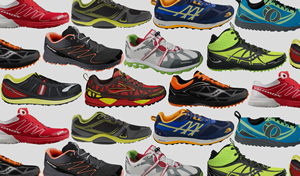Evaluate Your Running Shoes
 Shoes typically come with a “mileage,” usually around 300-700 miles. If your shoes look like they’ve seen better days, get yourself a new pair. If your shoes are old and worn out, they won’t be giving you the support that you need when you are running. The heel and the arch should be in optimal condition and your shoes should be designed for the terrain that you run on most. If you have heel or arch deficiencies (flat feet, high arches, etc.), make sure that you have the proper inserts for arch and/or heel support. These inserts can be found in almost any athletic shop. If your feet need to be diagnosed for orthotics, it is advisable to talk with your physician. You may also need to consider the terrain that you run on. Are your shoes designed to run on that specific terrain? If your shoes are designed for what you train on, it still may be beneficial to try another type of terrain such as concrete, track, gravel, beach, grass, etc., doing this can improve your strength and endurance. It may also work in your favor to give yourself a break from the hard terrain, but be sure not to take too many days off since you are preparing for a marathon. It is important to make sure you are fully ready for the terrain you will be running on for the big day. If you discover that running on concrete is not for you (because it results in shin splints, tendonitis or plantar fasciitis), maybe you should attempt to run some “cross-country” terrain type marathons such as wild running.
Shoes typically come with a “mileage,” usually around 300-700 miles. If your shoes look like they’ve seen better days, get yourself a new pair. If your shoes are old and worn out, they won’t be giving you the support that you need when you are running. The heel and the arch should be in optimal condition and your shoes should be designed for the terrain that you run on most. If you have heel or arch deficiencies (flat feet, high arches, etc.), make sure that you have the proper inserts for arch and/or heel support. These inserts can be found in almost any athletic shop. If your feet need to be diagnosed for orthotics, it is advisable to talk with your physician. You may also need to consider the terrain that you run on. Are your shoes designed to run on that specific terrain? If your shoes are designed for what you train on, it still may be beneficial to try another type of terrain such as concrete, track, gravel, beach, grass, etc., doing this can improve your strength and endurance. It may also work in your favor to give yourself a break from the hard terrain, but be sure not to take too many days off since you are preparing for a marathon. It is important to make sure you are fully ready for the terrain you will be running on for the big day. If you discover that running on concrete is not for you (because it results in shin splints, tendonitis or plantar fasciitis), maybe you should attempt to run some “cross-country” terrain type marathons such as wild running.

